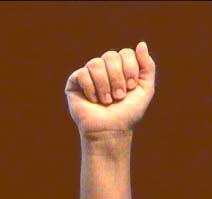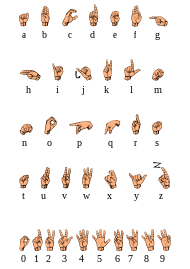Finger alphabet

The finger alphabet is used to spell the spelling of a word with the help of the fingers. The sign language (also Daktylologie is called) in addition to sign language to communicate with deaf or hard of hearing used to particular names and words to spell, for no sign character is still widespread. Finger spelling can also be used to emphasize a word and is then used in place of the relevant sign.
The international one-handed finger alphabet
The one-handed finger alphabet , with which the letters of the Latin script are reproduced with the fingers of one hand , is widespread internationally with a certain degree of uniformity . The reproduction with the fingers mainly follows the shape of the lower case letters. For example, the image of the letter “d” is signaled with the upright index finger , while the middle finger or the three other fingers form a circle with the thumb .
The oldest known publication of this finger alphabet is by Juan Pablo Bonet in 1620. The same alphabet was probably used by the Benedictine monks among themselves and used by Father Pedro Ponce de León to teach his deaf students the Spanish language.
National variants of the finger alphabet arise from the fact that, for example, special characters are created for particularly frequent sounds that are written with several letters. In the German language these are "sch" and the umlauts ä, ö and ü. In German-speaking Switzerland, Liechtenstein and Luxembourg the “ch” is added, in Germany, Austria and Luxembourg the ß . The hand shape for the letter "t" is also different.
The letters of the finger alphabet are executed with the dominant hand in front of the chest or slightly to the side of the trunk.
One-hand finger alphabet in German-speaking countries
The table below describes the individual hand signs (“hand shapes”) for the one-handed finger alphabet used in Germany, Austria, Luxembourg (German), Liechtenstein and Switzerland (German, French). Different hand signals appear in the respective language versions (see section Web links ) only for a few letters.
The descriptions refer to right-handers; left-handed people on the right instead of the left .
| Letter | description |
|---|---|
| A. | closed fist away from the body, thumb at the side |
| B. | Flat hand away from the body, fingers up, thumb on the palm |
| C. | The thumb and the rest of the fingers form an open semicircle |
| D. | Index finger up, thumb and remaining fingers form a closed circle |
| E. | Thumb in front of the palm, remaining fingers touch the thumb with fingertips |
| F. | Thumb and forefinger form a closed circle, the remaining three fingers spread parallel 1 upwards. 1 in the German, Luxembourgish and the finger alphabet of the French-speaking part of Switzerland they do not have to be completely parallel, in the German-Swiss, Austrian and Liechtenstein alphabets, importance is attached to this. |
| G | closed hand to the body, index finger points to the left |
| H | closed hand to the body, index and middle fingers point parallel to the left |
| I. | closed fist away from the body, thumb in front, little finger up |
| J | closed fist away from the body, thumb in front of it, little finger up, hand rotation around the vertical axis, French-speaking Switzerland : same, but with an open thumb |
| K | Index finger, middle finger and thumb spread upwards, remaining fingers on the palm |
| L. | Palm away from body, index finger up, thumb to the left, remaining fingers on the palm |
| M. | Palm down, index, middle and ring fingers stretched down, thumb under the fingers |
| N | Palm down, index and middle fingers stretched down, remaining fingers on the palm, thumb under the stretched fingers |
| O | The thumb and the rest of the fingers form a closed circle |
| P | Palm down, index finger forward, middle finger down, thumb touches the middle finger, remaining fingers on the palm |
| Q | Index finger and thumb stretched downwards, remaining fingers on the palm |
| R. | closed hand away from the body, index and middle fingers crossed and pointing upwards |
| S. | closed fist away from the body, thumb in front of the fingers |
| T |
Germany, Luxembourg, French Switzerland: closed hand to the left, index finger extended to the left, thumb on the index finger forward Austria, 1 Liechtenstein, German-speaking Switzerland: closed hand to the front, thumb extended upward, index finger on the thumb American finger alphabet: closed fist from Body gone, thumb under the curved index finger 1 In Austria, the variant of the German or Luxembourgish finger alphabet is sometimes used. |
| U | closed hand away from the body, index and middle fingers up together, thumb on the palm |
| V | closed hand away from the body, index and middle fingers spread upwards, thumb on the palm |
| W. | Flat hand away from the body, index, middle and ring fingers spread upwards, thumb on the palm |
| X | closed hand to the left, index finger up, but bent |
| Y | closed hand away from the body, thumb and little finger splayed upwards |
| Z | closed hand away from the body, index finger up, write a 'Z' in the air (zigzag movement) |
| Ä, Ö, Ü, ẞ |
German, Austrian and Luxembourgish finger alphabet: like A, O, U, S with a short downward movement of the hand Swiss-German and Liechtenstein finger alphabet: Like A, O, U, with Ä the thumb, with Ö the middle finger, ring finger and little finger parallel and at Ü the index finger and middle finger moved in parallel. ß: no equivalent (is not used in Switzerland and Liechtenstein, is spelled as "ss" there) |
| CH |
Swiss-German and Liechtenstein finger alphabet: thumb, index finger and middle finger form an open semicircle, ring finger and little finger are closed. Luxembourg finger alphabet: closed fist away from the body, thumb completely open. Not used in Austria and Germany: spell c, h |
| SCH | Flat hand away from the body, all fingers spread |
| Accents | French-speaking Switzerland : Accents of the French alphabet ( acute , grave accent , circumflex ) are optional and are included depending on the context. The basic shape is shown and the hand is moved according to the shape of the accent (for an é an E, the hand is moved upwards to the left, i.e. mirror-inverted from the point of view of the person who spells it, but correct from the point of view of the viewer) |
Other forms
In Japan, a finger alphabet character represents a syllable, corresponding to the Japanese syllabary writing hiragana . The forms of the alphabet are derived from the American.
In Great Britain, Australia, New Zealand, India, the Czech Republic and partly in South Africa, the finger alphabet is performed with two hands.
The Lormen is a tactile alphabet that German-speaking deaf-blind people can use to communicate.
See also
- List of sign languages
- History of Sign Languages
- History of the decimal system (finger numbers)

